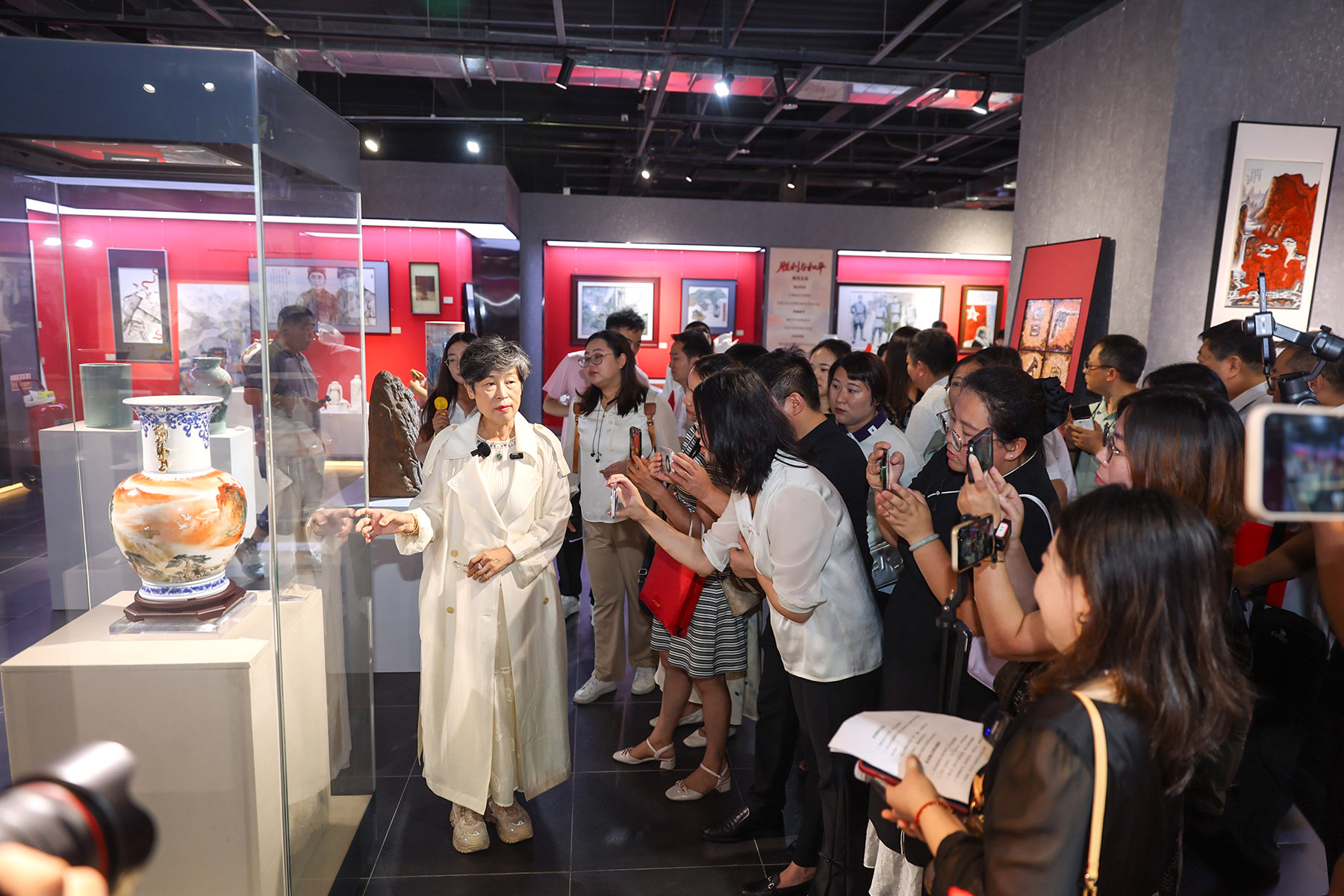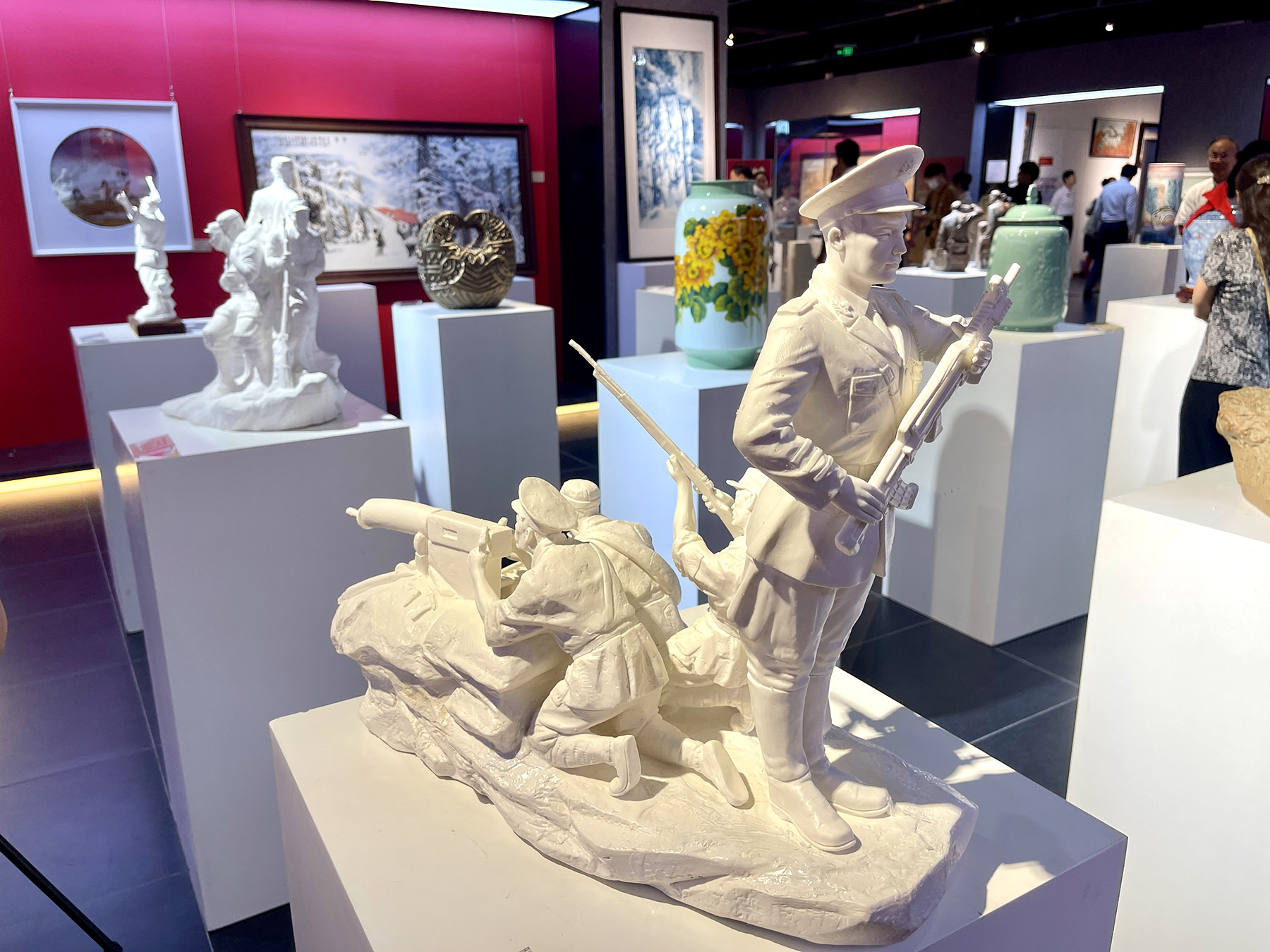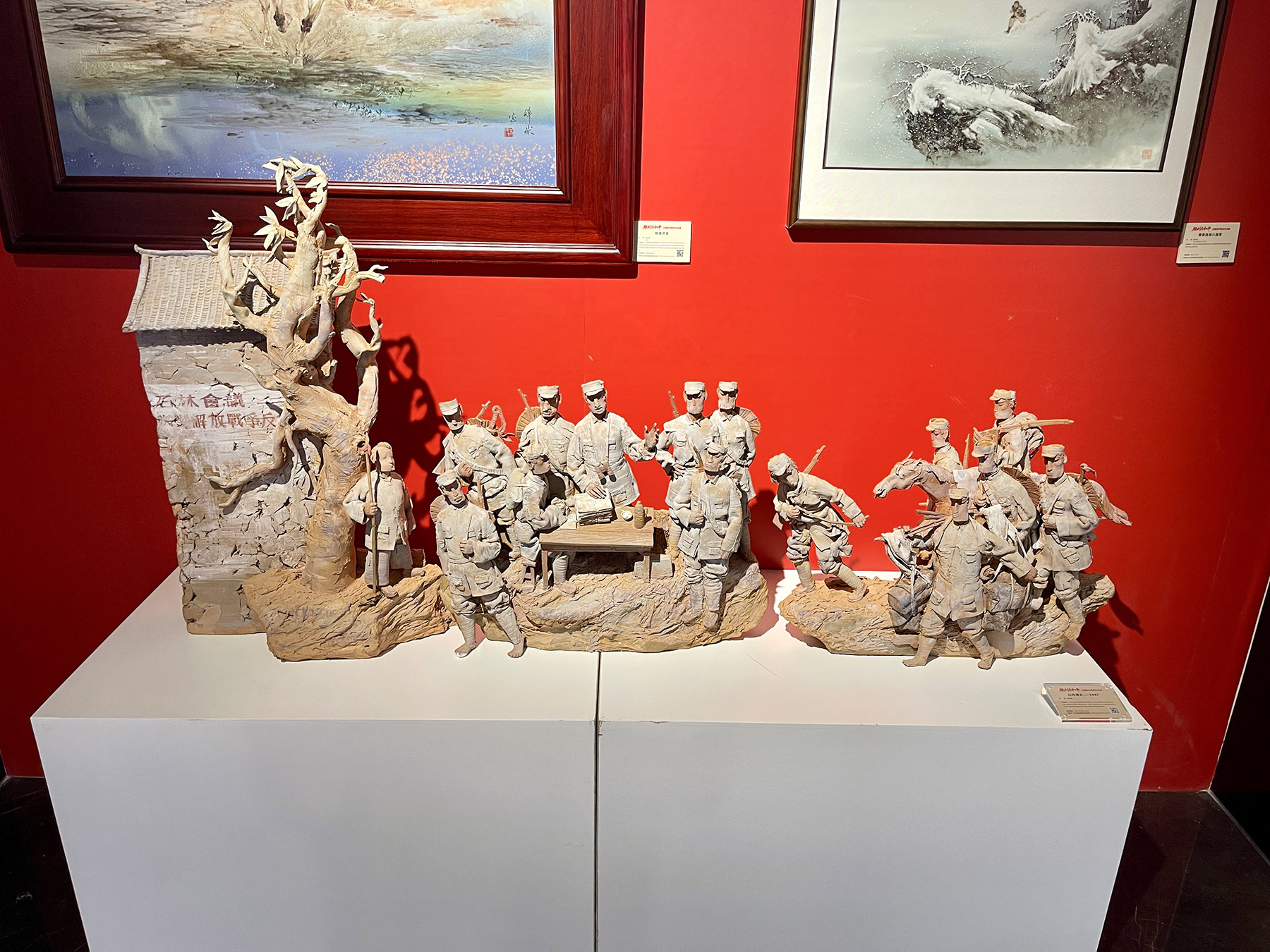Over 100 ceramic and porcelain masterpieces pay tribute to martyrs of war of resistance at ongoing exhibition, Yang Feiyue reports.

Beneath the soft glow of gallery lights, a monumental ceramic piece grips viewers with its stark intensity. Numbers marking the time period of the Chinese People's War of Resistance Against Japanese Aggression (1931-45) fractured and reassembled in porcelain intertwine with the silhouettes of rifles, uniforms, and the Great Wall.
The work, Remembering: 1931-1945, mirrors the chaos and endurance of a nation under siege, embodying life's fragility and memory's permanence, say its creators, the Chao brothers: Chao Ziyi and Chao Ziwei.
Nearby, the gleaming contours of Peaceful Flourishing Age take the form of a trophy, adorned with rising suns, peace doves, and the Yellow River flowing past evergreen pines. Its glazed surface becomes a declaration that peace is the highest form of victory.
READ MORE: Wartime relics tell of sacrifice and resolve
In solemn counterpoint, artist Lyu Pinchang's The Great Victory presents a porcelain warhorse burdened with weapons and armor. Fusing symbols of warfare with the steadfast horse, the piece reflects the brutality of conflict and the longing for peace.
In its stillness, the sculpture captures the pulse of battle, transforming silent clay into a vivid chronicle of war's fragile connection to life.
These works are among more than 30 items that open the chapter Flames of Memory — Porcelain Paints the Homeland at the Victory and Peace ceramic art exhibition in Beijing.
Through clay and glaze, artists re-create an era where blood and fire shaped destiny. The delicate yet enduring nature of porcelain stands in stark contrast to the cruelty of war, engraving the nation's collective memory with dignity, according to the hosts, the China Ceramic Industry Association and its partners.
Each fragile sheen carries both sacrifice and the enduring hope for peace.

Staged at the Beijing Ceramic Art Museum, the exhibition features over 100 masterpieces by more than 500 artists. Running until Sept 1 and open to the public free of charge, it stands as a significant cultural event commemorating the 80th anniversary of victory in the Chinese People's War of Resistance Against Japanese Aggression.
"Eighty years ago, the Chinese people, through immense sacrifice and unyielding will, secured a great victory," said Liu Ting, chairperson of the China Ceramic Industry Association, at the exhibition's opening ceremony on Friday.
He emphasized the exhibition's deeper meaning: "Ceramics, treasures of Chinese civilization, with their timeless quality, serve as an exceptional medium for recording history. With clay as paper and glaze as ink, we etch memory, carry forward spirit, and illuminate the future."
Liu praised the participating artists for skillfully blending historical themes with modern aesthetics, especially the young artists whose fresh perspectives keep the spirit of resistance alive.
The exhibition unfolds through three additional chapters, each offering a distinct yet interwoven perspective on the themes of sacrifice, legacy and peace.
The Iron-Blood Monuments — Sculpting the Soul chapter pays tribute to the noble spirit and immortal contributions of revolutionary martyrs. Through sculptures, porcelain vases and porcelain panels, ceramic artists shape vivid and towering figures, enabling viewers to feel the power of faith in solemn reflection and to recognize the backbone of the nation.
In Passing the Torch — Vessels Bearing Resolve, tradition is reignited through contemporary spirit. Innovative works by modern ceramic artists show how the legacy of resistance continues to resonate today. Artists reinterpret history through modern design language, weaving wartime elements into underglaze motifs and sculpted forms that symbolize resilience. Each vessel becomes a container of resolve.
The final chapter, A Flourishing Era — Porcelain's Hymn to Peace, marks the shift from chaos of war to the calm of peace. Through ceramic art, this section explores the eternal theme of war and peace, capturing the sweeping journey of the Chinese nation from suffering to rejuvenation. Artists use brilliant glazes and flowing lines to depict the prosperity of present-day China — lush mountains and rivers, peace and stability — set in stark contrast to the flames and smoke of war.
All the artworks encourage viewers to cherish peace and carry the wartime spirit forward, contributing to the great dream of national rejuvenation, according to the organizers.

Kang Ning, director of the publicity department of the Beijing-based Museum of the War of Chinese People's Resistance Against Japanese Aggression, described the themed exhibition as a vital step in encouraging ceramic artists to root their creations in the spirit of the times — to document a historic journey, promote national spirit, and share China's story with the world.
To ensure the exhibition captures the grand theme, the organizers invited governments of major porcelain-producing regions, provincial and municipal ceramic industry associations, and a wide network of ceramic artists.
"What touched us deeply was the overwhelming response from all sides," says Dong Bo, vice-chairman of the industry association.
"Ceramic artists poured their passion into works that use clay and glaze to recount those tumultuous years, while local governments and associations actively mobilized resources to support the exhibition," he notes.
Wang Jianzhong, professor at Tsinghua University, and one of the exhibition's judges, notes the poignant symbolism of using ceramics to remember the past.
"In the hands of the artists, cold clay becomes a vessel of memory. Every carved line recalls the sacrifice of the martyrs; every brush of color reflects the value of peace. This exhibition allows us to relive history through art, to recognize the high price of liberation, and to realize how hard-won peace truly is."
The diversity of participating regions and the enthusiastic response, he emphasizes, reflect the profound dedication of ceramic artists to honoring the nation's legacy of resistance and liberation.
ALSO READ: Exhibit chronicles doctor's dedication to China
Wang praises the ingenuity and thematic precision of the selected works, noting how they effectively embody the exhibition's core message.
"I hope this exhibition grows into a long-standing cultural brand, one that both honors the sacrifices of our forebears and inspires future creations rooted in wisdom, craftsmanship and spirit."
According to organizers, the finest works from the exhibition will be included in the China ceramic digital traceability certification system. Each selected piece will be given a unique digital identity, ensuring that its artistic and historical value is permanently preserved.
This initiative also provides ceramic art enthusiasts and collectors with a credible and authoritative platform for appreciation and collection, further promoting the popularity and development of ceramic art.
Beyond reflection, the exhibition seeks to become a cultural bridge — connecting China with the world and sharing its enduring message of peace and shared future through the timeless language of ceramics.
Contact the writer at yangfeiyue@chinadaily.com.cn


